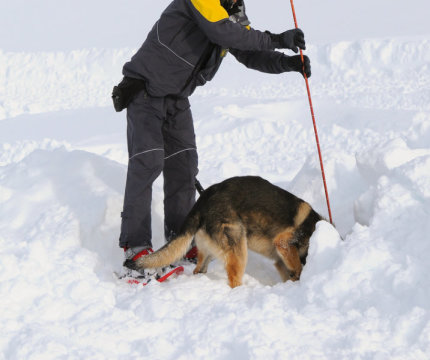[ad_1]
Human encouragement might influence how dogs solve problems, according to a new Oregon State University study.
The study, published in the journal Applied Animal Behaviour Science, sheds light on how people influence animal behavior, said study lead author Lauren Brubaker, a doctoral student in OSU’s Human-Animal Interaction Lab.
Brubaker evaluated the behavior of search and rescue dogs and pet dogs when presented with the same problem-solving task. Both sets of dogs persisted at the task for about the same proportion of time, but the search and rescue dogs were more successful at solving the task when encouraged by their owners.
However, the search and rescue dogs didn’t solve the task when they were alone. Further, pet dogs that solved the task with their owner present — but not encouraging them — also solved it when they were alone, Brubaker said.
“We thought that was unusual,” Brubaker said. “Because search and rescue dogs are trained to work independently, we expected that they would out-perform pet dogs on this independent task and that wasn’t the case. This suggests that the behavior of the owner, including their expectation of their dog and how they engage with their dog on a day-to-day basis, may influence the dog during a problem-solving task.
“This leads us to believe that communication between search and rescue dogs and their owner could be more effective than communication between pet dogs and their owners,” she said.
In the study, the dogs were given a solvable task with a person present: open a puzzle box containing a sausage within two minutes. They compared a group of 28 search and rescue dogs and a group of 31 pet dogs.
Search and rescue dogs were used as a comparison to pet dogs because they are traditionally trained to work independently from their owner. The search and rescue dogs were provided by Mountain Wave Search and rescue in Portland, Douglas County Search and Rescue in Roseburg, and Benton County Search and Rescue in Corvallis.
Pet dogs were recruited at random from the community through online advertisement and by way of word of mouth. Data from pet dogs from a 2015 study conducted by Udell were also used in the analysis. The dogs in both groups were from a variety of breeds.
The dogs were given the puzzle box under two conditions: alone in the room, and with their owner in the room standing neutrally. During the neutral phase, owners were instructed to stand in the room with their arms by their side and to avoid communicating with the dog. In the encouragement condition, the owner was instructed to encourage the dog however they saw appropriate, typically by using verbal praise or gestures, but without touching the dog or the container and without making contact with the dog or the container.
Before each condition the owner was instructed to “bait” the container by picking the container up, placing the food inside the container while the dog watched, and showing it to the dog to allow the dog to see that the container had food in it. Then they placed it on the ground in a designated location. In the neutral-human condition, the owner took three steps back and stood neutrally for two minutes. During the alone condition the owner left the room after placing the object on the ground.
In the human-neutral condition, three of the pet dogs and two of search and rescue dogs solved the task. Two pet dogs solved the task in the alone condition. In the encouragement condition, nine of the search and rescue dogs solved the task, while only two pet dogs did.
“When the owner’s social cues direct the dog towards the independent problem-solving task, then we see something interesting,” said Monique Udell, an animal scientist who directs the Human-Animal Interaction Lab in the College of Agricultural Sciences. “While most dogs increase the amount of time they spend attending to the puzzle when encouraged, pet dogs often end up treating the puzzle like a toy. Instead of engaging in goal directed behavior, they act as if their owner was encouraging them to play.”
Udell continued, “It’s possible that when directed by their owners, search and rescue dogs instead see opening the box as their job. Their owners may be more effective at communicating about the task at hand. Or maybe there is something inherently different about dogs that are selected for search and rescue that makes them more apt to solve the problem. More research is needed to know for sure.”
[ad_2]















